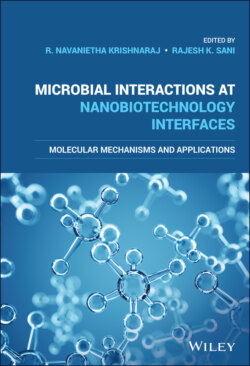Читать книгу Microbial Interactions at Nanobiotechnology Interfaces - Группа авторов - Страница 48
1.10.1 Size
ОглавлениеA key advantage of any NM system is its higher surface area‐to‐volume ratio in comparison to the micro and macro structures. Practically it is possible to contain a significantly high number of smaller NMs in comparison to bigger particles in the same volume. High surface area‐to‐volume ratio owing to an increased number of particles results in exposure of greater numbers of atoms, which could increase the activity. Considering the case of antibacterial system, the formation of biofilm is a key event in the development of resistant bacteria. Exposure of a greater number of atoms on the surface results in increased interaction of NM surface with bacteria, increasing the number of reactive oxygen species at a faster rate followed by inhibition or elimination of the bacteria. Supporting this fact, several recent studies have shown that the size of NMs plays a critical role in dictating the antimicrobial property of the NM.
Figure 1.5 Schematic of the factors influencing the antimicrobial activity of the NMs.
Generally, the smaller the size of NM the higher will be the surface area with a high chance of prolonged interaction with microbial system and high diffusion through the cell membrane in comparison to bigger NMs with smaller surface area (Gurunathan et al., 2014). In the case of silver NPs, the size of the NPs clearly influences the surface area exposure, release rate of silver ions, and the antimicrobial efficacy of the particles. Similarly, ZnO NPs of smaller size (12 nm) had better antimicrobial activity in comparison to larger particles of size 45 nm due to its high cell permeability (Padmavathy & Vijayaraghavan, 2008). In another study involving the TiO2 and silica NPs, the antimicrobial property and the mechanism of action of the system were influenced by the size of titanium nanotubes (Çalışkan et al., 2014). In contrast, a study involving three different sizes of Mg(OH)2, the smallest NPs had the least antibacterial effect (Pan et al., 2013). Thus, it is necessary to consider the effect of other factors also with size in determining the mechanism action of NMs.
